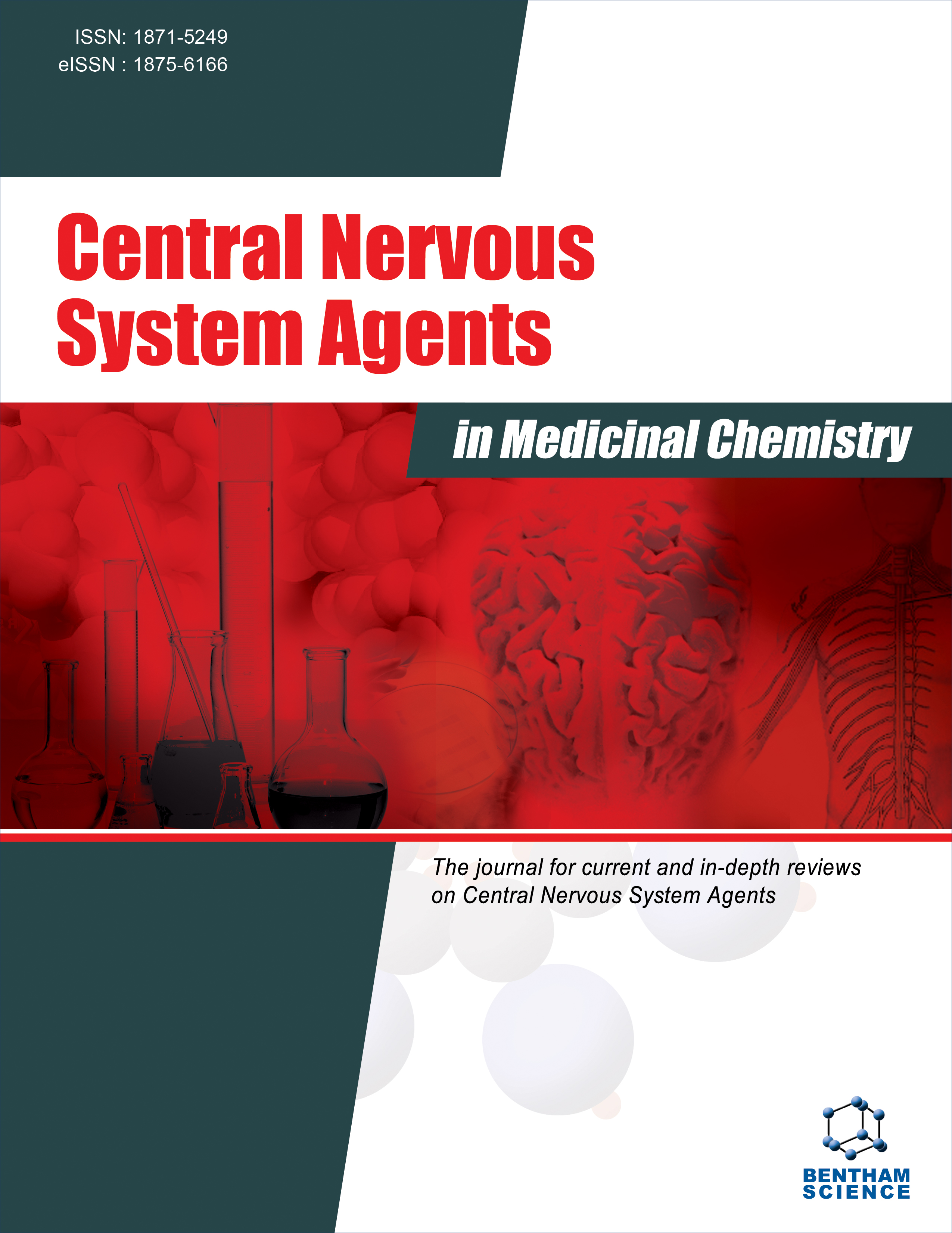- Home
- A-Z Publications
- Central Nervous System Agents in Medicinal Chemistry (Formerly Current Medicinal Chemistry - Central Nervous System Agents)
- Previous Issues
- Volume 17, Issue 3, 2017
Central Nervous System Agents in Medicinal Chemistry (Formerly Current Medicinal Chemistry - Central Nervous System Agents) - Volume 17, Issue 3, 2017
Volume 17, Issue 3, 2017
-
-
In vivo Piroxicam Metabolites: Possible Source for Synthesis of Central Nervous System (CNS) Acting Depressants
More LessBackground: Piroxicam has been reported to be convertible to Central Nervous System (CNS) acting agents. It has serious depressant effects at high doses. Objective: In view of this, structures of piroxicam metabolites were assessed for possible conversion to CNS depressants. Methods: Literature search was carried out with intent to identifying piroxicam metabolites and the possibility of converting them to CNS acting de Read More
-
-
-
Functional Chemical Groups that May Likely Become a Source for the Synthesis of Novel Central Nervous System (CNS) Acting Drugs
More LessIntroduction: Central Nervous System (CNS) disorders are on increase perhaps due to genetic, enviromental, social and dietetic factors. Unfortunately, a large number of CNS drugs have adverse effects such as addiction, tolerance, psychological and physical dependence. In view of this, literature search was carried out with a view to identify functional chemical groups that may serve as lead molecules for synthesis Read More
-
-
-
Green Tea (Camellia sinensis) Protects Against Arsenic Neurotoxicity via Antioxidative Mechanism and Activation of Superoxide Dismutase Activity
More LessBackground: Chronic arsenic-exposure even at a low-dose results in the neural impairment and motor/cognitive dysfunction. However, several preventive approaches are made mainly against hepatic/ gastrointestinal damages. Only a few investigations postulate therapeutic strategies for neural anomalies. Here, the protective role of Green tea (Camellia sinensis or CS; 10mg/ml aqueous) has been evaluated against arseni Read More
-
-
-
Pharmacological Evaluation of the Recuperative Effect of Morusin Against Aluminium Trichloride (AlCl3)-Induced Memory Impairment in Rats
More LessBackground: Elevation in brain levels of aluminium can be neurotoxic and can cause learning and memory deficiencies. In Chinese medicine, Morus alba is used as a neuroprotective herb. The current study was intended to discover the recuperative effect of morusin against aluminium trichloride (AlCl3)-induced memory impairment in rats along with biochemical mechanism of its protective action. Methods: Memory deficiency was Read More
-
-
-
Synthesis and Evaluation of Novel Diazaspiro Hydantoins as Potential Anticonvulsants
More LessBackground: Epilepsy, one of the most frequent neurological afflictions in man characterized by excessive temporary neuronal discharges resulting in uncontrolled convulsion, requires special medical attention. Though several new anticonvulsants are introduced, some types of seizures are still not adequately treated with current therapy. Toxicity, intolerance, and lack of efficacy for certain types of seizure are some of the limitat Read More
-
-
-
Investigation on the Molecular Interactions Stabilizing the Structure of α-synuclein Fibril: An In silico Study
More LessAuthors: Airy Sanjeev and Venkata S.K. MattaparthiBackground: Amyloid fibrils represent stable form of many misfolded proteins associated with numerous diseases like Parkinson's Disease (PD), Type II diabetes and Alzheimer's disease (AD). α-synuclein protein is the principal constituent of Lewy bodies that are considered to be pathological hallmark of PD. Recently, a high resolution structure of α-synuclein protein that stacks together forming fibrils in brains of PD patients w Read More
-
-
-
Novel Mannich-bases as Potential Anticonvulsants: Syntheses, Characterization and Biological Evaluation
More LessAuthors: Amit K. Keshari, Aseem Tewari, Shweta S. Verma and Shailendra K. SarafBackground: Mannich bases are known to be an important pharmacophore or bioactive leads in the synthesis of various potential agents that have a variety of therapeutic activities like anticancer, antipsychotic, anticonvulsant, antimalarial, anti-inflammatory, antibacterial and so forth. Thus, in the present research, conjugation of moieties like 1,5-benzoxazepines and 1,5-benzothiazepines with secondary amines like piperazine, Read More
-
-
-
Synthesis, Computational and Pharmacological Evaluation of N-(2-benzoyl- 4-chlorophenyl)-2-(4-(Substituted Phenyl) Piperazin-1-yl) Acetamides as CNS Agents
More LessAuthors: Shweta Verma, Surendra Kumar and Sushil KumarBackground: A series of new N-(2-benzoyl-4-chlorophenyl)-2-(4-(substituted phenyl) piperazin-1-yl) acetamides (3a-j) have been synthesized by the chloroacetylation of 2-amino-5- chlorbenzophenone which was further reacted with substituted phenylpiperazine. Material: The chemical structures of the compounds were confirmed on the basis of their TLC, IR, 1HNMR, 13CNMR and by elemental analysis. The physicochemical simila Read More
-
-
-
Homology Modeling Inspired Synthesis of 5-HT2A Receptor Inhibitors: A Diazepine Analogue of the Atypical Antipsychotic JL13
More LessBackground: The benzoxazepine JL13 is an analogue of the clozapine family of antipsychotic agents which target the 5-HT2A receptor, and has showed promise as an atypical antipsychotic agent. Based on the dearth of clinically effective anti-psychotic agents available, we sought to design and chemically synthesize additional analogues. Methods: Structure function analysis was conducted using state of art computational m Read More
-
Volumes & issues
-
Volume 25 (2025)
-
Volume 24 (2024)
-
Volume 23 (2023)
-
Volume 22 (2022)
-
Volume 21 (2021)
-
Volume 20 (2020)
-
Volume 19 (2019)
-
Volume 18 (2018)
-
Volume 17 (2017)
-
Volume 16 (2016)
-
Volume 15 (2015)
-
Volume 14 (2014)
-
Volume 13 (2013)
-
Volume 12 (2012)
-
Volume 11 (2011)
-
Volume 10 (2010)
-
Volume 9 (2009)
-
Volume 8 (2008)
-
Volume 7 (2007)
-
Volume 6 (2006)
Most Read This Month
Article
content/journals/cnsamc
Journal
10
5
false
en


